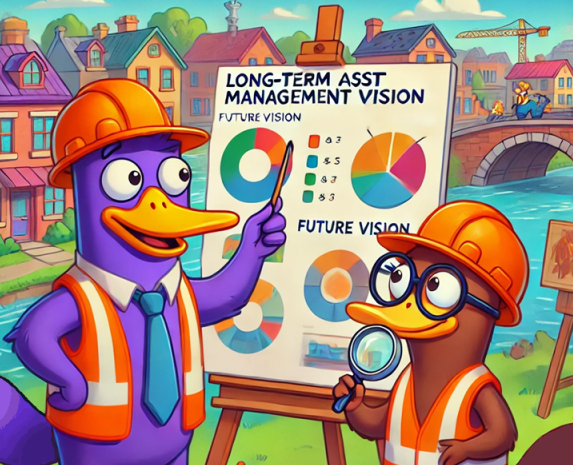
From script by Lou Cripps
Infrastructure schemes tend to suffer from optimism bias: assuming everything will work as planned.
Focusing on benefits and forgetting some costs is one reason infrastructure projects tend not to be as good as their business cases.
But there’s a parallel problem with risk and time.
Hofstadter’s Law: It always takes longer than you expect, even when you take into account Hofstadter’s Law.*
The UK TV programme Grand Designs comes to mind in relation to projects. It doesn’t seem to matter how many years the programme has been running, or the presumption that people who appear on it will have actually watched previous episodes.
In ambitious projects for houses, there seems to be a McCloud Law at work. People will always plan to be in by Christmas, unless they are expecting a baby (in which case they want to be in just before it is born).
In the UK, that means they are probably rushing to weatherproof the house in November, so they can get to work on the interior. And this in turn means they are invariably dependent on it not raining until the roof and windows are installed.
So the question is, is it likely to rain in the UK in November?
There is a technical corollary to this: that the glass for the windows will be delivered late, in any case. Apparently all builders know this.
*Coined by Douglas Hofstadter in his book Gödel, Escher, Bach: An Eternal Golden Braid (1979). McCloud after Grand Designs’ presenter Kevin McCloud.

From script by Lou Cripps
Sometimes, it feels too much to do it all step by step.
Most organisations I work with don’t yet have any asset plans beyond five years. Some still only have annual budgets. How do you add in changing requirements for the longer term if you don’t even ask past five years?
And how many years ago did asset managers realise you can’t plan if you don’t think about where you want to get to? (At least 20, because strategy comes before planning in BSI PAS-55 published in in 2004.) But almost no-one has properly strategic ‘asset strategies’. They literally don’t know where they want to take their assets.
Bit by bit – and maybe getting nowhere fast.
But there is an alternative, maybe. Can we describe a compelling vision of where we want to be, first?
Can we even leapfrog some of the gradualist things we currently do?
Gradualism may be personal preference, or professional training. We haven’t always been bold about our mission. Some of us are detail people.
How would it be if we really believed we have a duty of care to make a big difference to the, frankly, fairly dumb way we’ve conventionally managed infrastructure?
Todd Shepherd and Julie DeYoung describe this as a system thing. What we have is a system, or paradigm, which resists change – so tinkering at the edges doesn’t work, because the old system will just bounce back as soon as you stop pushing.
This is, of course, quite a different concept of ‘system’ from the parts and pieces idea of a ‘quality management’ approach such as ISO 55000, which instead encourages a bit by bit, start with AM policy or SAMP. Better than thinking the first step has to be IT – but possibly no more ‘sticky’.
Quicker, and less heartache, to go for undermining the whole thing with strategy and long-term planning from the start?

from script by Lou Cripps
Just a thought about current Asset Management practice.
One core tool used by many is the maturity assessment or gap analysis. See, for example, the Institute of Asset Management’s SAM+ tool.
The concept here is to audit an organisation against a standard, recognise its shortfalls against that standard, and recommend actions to close the gaps – in an implementation plan often referred to as the Asset Management roadmap. The standard could be ISO 55000 series, or perhaps more usefully the 39/now 40 subjects in the GFMAM Asset Management Landscape.
ISO 55000 has some oddities (don’t get me started here on the terms ‘SAMP’ and ‘asset management plans’), but the involvement of far more people in the revision in 2024 probably makes its coverage more realistic.
The problem with the world of AM assessments and roadmaps isn’t fundamentally which topics we assess.
It’s that we simply don’t take our own principles seriously.
Alignment with organisational objectives is surely the key organising concept in ISO 55000. And yet we still propose AM implementation against standards – rather than our corporate priorities.
We also have a history collectively of ridiculous outputs, roadmaps that detail 70 or 130 different actions, for AM teams of perhaps 2 or 3 people to implement in the next 2 years – as though we had no experience, no common sense of what it’s like to implement major change. Almost as though we aren’t taking the AM Landscape ‘red box’ Organisation & People into account at all.
In Asset Management, there isn’t a ‘right’ way to do everything. That’s engineer talk. The optimal way forward is the best realistic option for us, for where we are now, for what our organisations are trying to achieve.
Sure, there are some things which are probably always a bad idea to do, and some that are usually good. But it’s not about a set of rules. Not a template we can fill in, leaving our brains in a jar somewhere.
Whatever we call it, a top-level strategy for Asset Management is essential. But it only makes any sense as a case for how AM will contribute to our organisational targets and challenges. And the practical actions that will do most to support the overall business strategy.
Yeah, the answer is almost always going to be a better planning process for our assets.
But if we start by taking something from inside AM, like ISO 55000 or GFMAM 40 Subjects, and use that as a basis to propose priorities for implementation, we are doing what asset people have too often done before.
Ignoring the business priorities. Not being aligned, right from the start.
Instead, the first thing is to make sure we really understand the organisational challenges, by talking with the people at the top. They won’t always be crystal clear, but that’s the right terrain to start with. Perhaps we’ll even be able to assist in articulating the challenges.
Then talk about what we can realistically do with AM to meet them.*

The gap assessment we require is the gap between what AM could usefully do for our organisation and what we are actually achieving at the moment.
*In my mind, there is very little chance that the corporate priorities for infrastructure won’t require good Asset Management, urgently. We are definitely not at risk of talking ourselves out of a job.

Recent Comments